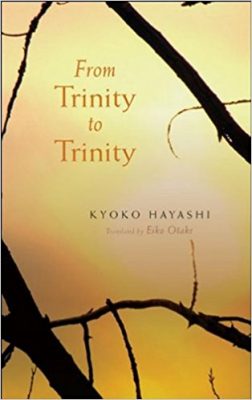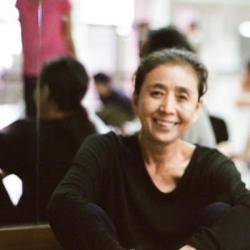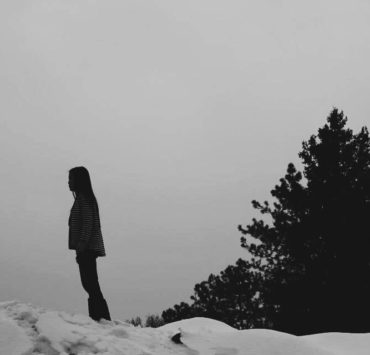
<Trinity Sites> is on the outskirts of the town of Alamogordo, 190 kilometers southeast of Albuquerque.1 Soon after the streetlights, smoky with morning mist, were put out, our car drove into a dusty wilderness. Our view opens up in all directions, and to the left of the road, mountain peaks far in the east start to shine a golden color. The rising sun is behind the mountains, and the slopes that have the sun on their backs lie in black shadow. On the right, as time passes, the faces of the mountains in the west show a light expanding from their peaks toward their grassy bottoms. As we drive, the ridgeline of the mountains begins to change, so that the sun goes down behind a mountain and then rises again above another mountain. Responding to that, the mountains in the west become dark and, at the next moment, grass on the surface of the same mountains shines like a girl’s blond hair. Soon grassy areas wet with dew waved like river fog, and the morning sun showed its complete face. Forty minutes have passed since we left the hotel. There are no cars coming toward us. On the earth or in the sky, I see no human or other living creature. A little after 8:00 a.m., we arrived at a rest area on a highway that was constructed by putting together thick planks of lumber. This is the first building we have seen since we started our drive today. This rest house is built out of logs without any windows or doorways.
It is only equipped with water and a bathroom. The bathroom alone has walls and a door where an Indian man stands as a guard. Tsukiko asked me, I want to smoke, is it OK? And she then drove to a concrete parking lot in front of the building. There were several trucks and passenger cars. A man, his boot resting on a truck window frame, was taking a nap. It seems he had been driving a long distance. Tsukiko parked her car next to his truck.
Smoking a cigarette, Tsukiko crosses a wooden bridge toward the rest stop, which is built above ground. Looking back from an information board that had a sign with red letters, she said, here, they say Watch Out for Rattlesnakes. Surprised, I asked, you mean rattlesnakes? Yes, it says rattlesnakes. “Do not step off the concrete paths and wooden bridges. It is forbidden to let pet dogs loose. If you do not follow these rules and get bitten by a snake, you are responsible for any damage.” OK? Tsukiko reminded me again as the morning chill was making my back curl.
Following Tsukiko I walked over the bridge and stood facing the wilderness to the west. The field stretched up to the foot of the mountains. I took a deep breath. Under these grasses, snakes hide themselves waiting for their prey. The warning told us not to walk away from the bridge. So perhaps there are snakes right underneath me in the grass, which I might be able to see from cracks in the wooden bridge.
How might the snakes’ bodies look and what color are their eyes? Blue? Red? Like Fat Man and Little Boy, rattlesnakes are killers, so they probably have no wasteful lines in their bodies. In the wilderness of the West, I imagined a rattlesnake from Steinbeck’s <<The Snake.>>
Steinbeck describes a rattlesnake that is aiming at a catch: <see! he keeps the striking curve ready. A rattlesnake is a cautious, almost cowardly animal.> <The mechanism of its body being extremely delicate> this Texas-born protagonist <The Snake> is a big snake big snake <nearly five feet long.>
It looks like an animal perfectly made for a wilderness that is just starting to dry in the morning sun. It would not be strange if a five-foot long snake were looking up at Tsukiko and me. I do not need a fivefoot rattlesnake. So I walked only on the concrete path and the wooden bridge and then got into the car.
The sun started to hurt our eyes. It was two hours and forty minutes since we had departed, and the scenery was starting to show subtle changes. The field, looking like a scrubbing brush, is still the same, but now I see scattered plants as tall as boys. A man who is familiar with the area would know his location by looking at the plants, but the is a hidden place not listed on maps. The only things that made us guess we were near our destination were an iron tower on a plateau ahead of us and a huge, parabolic, dish-shaped antenna.
It looks like we’re here, Tsukiko said and slowed down her car. Fifty meters ahead of us are several cars.2 A female officer, who was talking with a driver, raised her hand to order us to stop. She comes by and with a knock on our car window says, the <Trinity Site> is under U.S. Army jurisdiction. Please open your window. Ahead on the road, which she says the is under military jurisdiction, is a wilderness. A fence built with barbed wire and logs is open. This fence is the gate of the <Trinity Site.>
The officer saw Tsukiko and me and confirmed, two of you? Then she offered us two printed papers. Read and sign, she states. It is <13 Rules on Visiting.> The gate opens at 8:30 a.m. and last entry is at 2:00 p.m. If a person enters the gate at 2:00 p.m., visits and walks around within the fence, he/she will not leave the gate before 3:00 p.m. The night falls fast in wilderness and that would make a visit after 2:00 p.m. dangerous. As if predicting and dealing with such danger, there was a clearance of responsibility, This was on a bulletin board. Then came a printed The fence is easy to jump over, but they gave us a round of warnings:
– Demonstrations, picketing, sitting, marches, political speeches, and other such activities are forbidden.
– No carrying of any arms on the White Sands Missile test site.
– Do not pick up any in <Trinitite> in <Ground Zero>. Not only is the National Monument <Trinity> radioactive, but the plants are also.3
– Be careful of snakes. Rattlesnakes have been seen at and the McDonald Lunch House.
– Leave your pets in your car. When doing so, keep windows open. High heat can kill your pet quickly.
We signed the paper and were allowed to enter. We drove on a long narrow road that was bordered by a fence. Once again, an officer instructed our car to stop. From that point on vehicles were no longer allowed and the <Trinity Site> starts.
In the rules we read <Trinitite>, referred to all materials in the <Trinity Site> such as stones, glass pieces, grass, flowers, soil, and sands. The <Trinity Site> means a small wasteland surrounded by fences about three meters high that is itself within a wasteland. At the approximate center is <Ground Zero,> where the plutonium bomb was detonated for its explosion test. At <Ground Zero> is a <National Historic Monument.> It is a quadrangular pyramid constructed of stones. It is about three meters high.4 In short, everything in the <Trinity Site,> even a little dirt on the back of our shoes, is a national secret put on display.
In the fenced area is an open space that could encompass six or seven baseball fields. I hear that areas around here, including those outside the fence, are missile test sites. I do not think White Sands, printed on the tourist photo guide, is the same place as White Sands, the missile test site, but I learn that “more than 42,000 missiles and rockets have been fired at the range since 1945.” There was a warning, “Be careful: in the firing range explosives might be found in the ground. This is a known fact.”
A small booklet, <Trinity Site 1945–1995,> says:
Radiation levels in the fenced ground zero are low. On average the levels are only ten times greater than the region’s natural background radiation. A one-hour visit to the inner fenced area will result in a whole body exposure of one-half to one milliroentgen. To put this in perspective, a U.S. adult receives an average exposure of 90 milliroentgens every year from natural and medical sources. For instance, the Department of Energy says we receive between 35 and 50 milliroentgens every year from the sun and from 20 to 35 milliroentgens every year from our food.—The decision is yours.5
The danger is well explained.
If a person stays in the fenced area for one hour, 0.5-1 milliroentgen will be added to his body. Since the average American adult takes in 90 milliroentgens per year, one cannot say that the radiation a person receives at the <Trinity Site> is low.
Getting out of the car holding a mineral water bottle, the only thing allowed, we walked into the fenced area. There are about two hundred visitors. Many are with families, and I spot fathers holding children’s hands. Visitors walk looking down. Maybe they are careful of the needles of desert plants and small radio-active weeds at their feet. The only things that move in this wilderness are humans walking in the <Trinity Site.> In the treeless field, it seems even a bird cannot make a nest.
I tried to listen to the quiet of the wilderness. I wanted to hear the small but lively sound of popping seeds from the pods warmed by the sun. Even the sandy noise an insect makes as it falls into a pit of ant lions would do. I wanted to hear the kind of noise a living thing makes.
I walked to <Ground Zero.> When I reached the outer circle of visitors surrounding the stone memorial, I stopped. I turned my face to look around. As far as I could see was a field with no place to hide. The only things higher than the ground were humans, the fences surrounding the red mountains on the horizon, and one thing more. In the center, in front of me, is a memorial to <Ground Zero.>
From this point in July, fifty years ago, the flash of light of the atomic bomb ran all directions in the desert. I heard, on the day of the experiment, it had been raining hard since morning, unusual in New Mexico. The experiment was carried out in the heavy rain.6
The flash of light boiled the downpour and, with that white froth, ruined the fields, burned the helpless mountains, and shot up to the sky. And then silence. Without time to defend and fight back, the wilderness was forced into silence.
From the bottom of the ground, from the exposed red faces of faraway mountains, from the brown waste-land, the waves of silence came lapping and made me shudder. How hot it must have been—.
Until now as I stand at the I have thought it was we humans who were the first atomic bomb victims on Earth. I was wrong. Here are my senior hibakusha. 7 They are here but cannot cry or yell.
Tears filled my eyes.
I have always been aware of being a hibakusha. But as soon as I started walking through the small passage within the fenced area led by a guide, my always-present awareness of being a victim disappeared from my mind. It was as if I became a fourteen-year-old again. I may have been walking toward an unknown <Ground Zero> as though I were someone from <the time> before August 9, but it was when I stood in front of the memorial that I was truly exposed to the atomic bomb.
Looking back, I did not shed a tear on August 9. As I ran with the pack of people whose hands, feet, faces no longer looked human, no tears came to me. Like ants on a midsummer road, there was a line in the burned field of Urakami.8 It was a line of people who could walk and had come for treatment. Facing that line was a doctor at work. The head of the doctor, who was sitting on a stone, was also covered by a bandage. Nagasaki was completely ruined. I could see all the way to the sea. The only things higher than the ground were people. I ran and ran, glancing at scenes lit by fire.
Three days later my mother came to look for me from the village where my family had moved to escape the war. On the way, she met the mobilized students going to rescue the victims. My mother told them the name of the place I worked and asked them to get my bones if they saw some small ones.
When she found me without a wound, my mother said, you are alive. She embraced me and cried. But I still did not shed my tears. For the first time, here at Trinity, however, I might be crying with the human tears that I did not shed on August 9. Standing on the land that speaks no words, I shivered, feeling its pain. Until today, I have lived with merciless pains that hurt both my mind and body. But it could have been the pain of the skin that grew from August 9. Here in this desert I had momentarily forgotten my life as a hibakusha. Over the land that keeps its silence I must have been seeing the scene of the day when I ran away. I have tried to suppress that scene in my mind over many years. Me on that fatal day.
I saw the back of an old man walking toward <Ground Zero.> Away from any other groups of people, he walks alone with a cane. Is he about seventy-two or seventy-three years old? He is tall and was built with a sturdy frame. He looks like a wounded veteran. Maybe because he has bad eyes, he wears darkly shaded glasses. Nobody accompanies him. Perhaps he wished to visit <Ground Zero> while he can still travel and join a bus tour. I was attracted to the sorrowful old man. How has he lived his life since the War? Since he came all the way expressly to visit the <Trinity Site>, like the old man in the museum and Tsukiko’s husband, this man probably also fought in World War II.
The man walked, letting his stick investigate the <Trinity Site>, and at the outside of the crowd that circled the monument, he stopped. Resting both hands on the top of his stick, the man is looking at the monument from far away.
Three or four boys wearing camouflage clothes run by the old man. Another boy is playing alone, throwing a red Frisbee into the blue sky.
Fat Man, which was in the Atomic Museum in the Air Force Base until yesterday, was brought here during the night and is now on display inside the fence. This is the same style, a brother-like bomb, as the plutonium bomb used for the test explosion. It returns home twice a year.
Tsukiko and I were walking hand-in-hand. In the grass were a few five-petaled flowers similar to the Japanese quince that I see often in the Japanese hills and fields. Yellow and shiny flowers are also blooming. 78 Kitchen Table Translation Tsukiko and I sat and looked at the flowers that bloomed close to the ground. I wonder if Kana is alive, Tsukiko asked me suddenly. She is fine, I said.
After looking at the crater blasted by the test explosion, we walked to the exit. There was a crowd near the exit, which was also an entrance. We did not notice it when we came in, but there was a wooden table, on which there were broken parts of instruments used in the test explosion, an alarm clock and pieces of iron parts. A female officer was putting a Geiger counter on the alarm clock. The hand shook vigorously and the detector started ringing.
These were the instruments used in the test on that rainy day. Radiation still remains, she explains, pointing the Geiger counter at the clock’s hand. Like a wave, the sound becomes bigger and smaller. Oh! The Americans shake their heads. They seem to be moved by the power that remains a half-century later. Is it not something? Tsukiko and I also nodded our heads.
The officer looked content with the reception. I was watching in awe with the people who gathered around the table. Realizing how ridiculous it is for me to be among them, I felt like I wanted to put that Geiger counter on my body as a demonstration. When it starts to ring Gaaaaaaaaaa they would be surprised, I thought.
How long radiation remains once it is released on Earth varies depending on the materials, but they say it lasts almost eternally. My acquaintance in France told me that upon entering the room of Madame Curie, the detector still starts to ring.
Next to the rusted instruments were small stones in a glass container. About one centimeter in diameter, the small stones are perfectly round. The stones as a whole look gray, but looking closer, they reveal grains of white, brown, green, and red sand. The officer pointed to one stone that had no shine, and started to explain:
“This small stone was made when the atomic bomb explosion blew up the earth’s sand and soil, which danced together in the air, mingled, melted in the high heat, and got jammed together into a ball shape. We call this small stone a pearl,” he said. The stone was a perfectly shaped sphere.
The crew of Bockscar that attacked Nagasaki wrote, <on the ground many more things were happening than what was seen at the test explosion in the desert of Alamogordo, New Mexico.> Did the people who were melted in the high heat also become small stones and dance in the air? Someone told me the bones of young people shine pink. I wished the bones of my dead friends would at least become lovely pink pearls.
In front of the table displaying <pearls,> local journalists were preparing for an interview. Two Japanese men were standing surrounded by people. They are hibakusha from Hiroshima who will be interviewed. Among the American onlookers, the two men in T-shirts stood with tense expressions.
With their heads up, they stood straight.
1. Approximately 120 miles.
2. Approximately 165 feet.
3. Trinitite is the name given to the soil that was fused into glass-like objects by the heat from the Trinity atomic bomb test. Trinitite is typically a grayish or light olive green color, with a smooth, fused top surface on one side and the irregular texture of the sandy desert surface on the other side. While the Bureau of Atomic Tourism website (www.atomictourist.com) warns that Trinitite is “still radioactive and must not be picked up,” it is reported that by the early 1950s the government had excavated and buried almost all of the Trinitite remaining at the site. On one commercial website, Mineralogical Research Co. (www.minresco.com), Trinitite pieces are called collectors’ items and are sold as “Products of the First Atomic 80 Kitchen Table Translation Bomb Explosion.” This site claims that Trinitite was “highly radioactive in 1945,” but that its radioactivity at the present is “virtually zero.”
4. Three meters is nearly ten feet.
5. The same information is found at the website, White Sands Missile Range Public Affairs Office, “Trinity Site Pamphlet.”
6. It turns out that Hayashi’s description here is not completely historically accurate, the details and significance of which I discuss in the Afterword of the book From Trinity to Trinity.
7. Hibakusha is the Japanese word for a victim (or victims) of the atomic bombings.
8. Urakami was the epicenter of the atomic bomb explosion on August 9, 1945. It was the site of Urakami Cathedral.
Kyoko Hayashi is a celebrated Japanese author born in Nagasaki in 1930. After spending most of her childhood in Shanghai, in 1945 she returned to Nagasaki where she was mobilized to work full time in a munitions factory while still a student. Having lived through the atomic blast that destroyed the city on August 9, she eventually began to write, chronicling the stories of hibakusha (atomic bomb survivors). Hayashi first gained wide recognition in 1975 when her story “The Site of Rituals” (Matsuri no ba) won the prestigious Akutagawa Prize. Since that time, she has continued to write about the atomic bomb in her semi-autobiographical short stories and novels, receiving numerous awards. In 2005, the eight-volume Kyoko Hayashi Complete Works (Hayashi Kyoko Zenshu) was published in Japan, marking the sixtieth anniversary of the nuclear attacks.
Eiko Otake’s translation is excerpted from from her full-length translation of Kyoko Hayashi’s From Trinity to Trinity (Station Hill Press, 2010) and is reprinted with permission from Station Hill Press.

Image Credits: Leigh Klotz

Eiko Otake is a Japanese choreographer/dancer who has lived in New York since 1976. Since 1972 she and her partner Koma have collaborated as the performance team Eiko & Koma, creating and presenting a unique theater of movement in diverse venues worldwide, including numerous appearances at the American Dance Festival, the Brooklyn Academy of Music’s Next Wave Festival, and a month-long “living” gallery installation at the Whitney Museum of American Art. Eiko & Koma have received many honors, including a MacArthur Fellowship in 1996.







